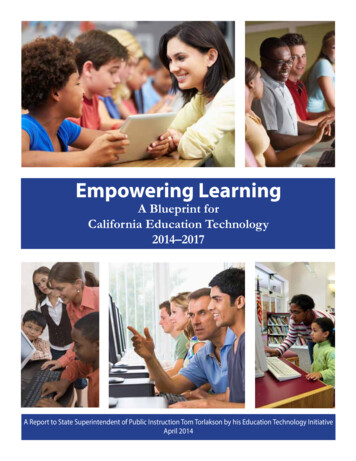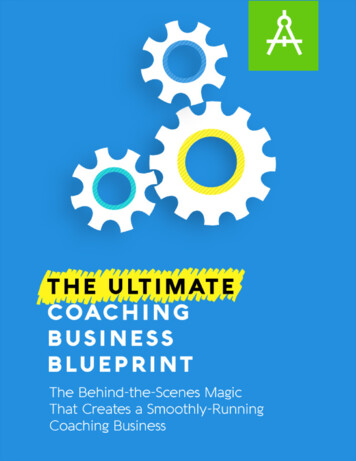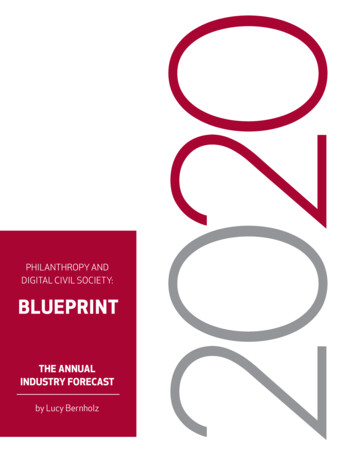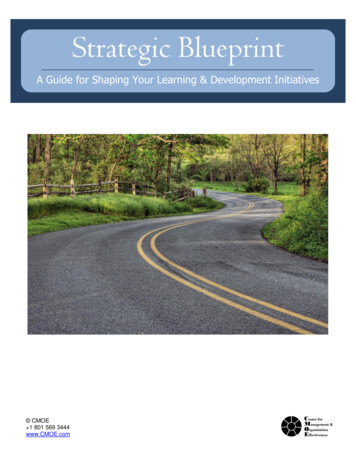
Transcription
Empowering LearningA Blueprint forCalifornia Education Technology2014–2017A Report to State Superintendent of Public Instruction Tom Torlakson by his Education Technology InitiativeApril 2014
Empowering Learning: California Education Technology Blueprint, 2014–2017, is the product of theSuperintendent’s Initiatives Office of the California Department of Education under thedirection of State Superintendent of Public Instruction Tom Torlakson and in collaborationwith the California Department of Education’s Educational Data Management Division.
Table of ConTenTsA MessAge FroM the stAte superintendent oF public instruction . 1executive suMMAry And the cAliForniA context . 3educAtion technology tAsk Force. 8blueprint recoMMendAtions . e.18Appendix A: blueprint developMent process . 21Appendix b: blueprint conceptuAl FrAMework . 23bibliogrAphy . 24educAtion technology tAsk Force MeMbers . 26speciAl AcknowledgeMents . 29
This page intentially left blank.
a Message froM The sTaTe superinTendenT of publiC insTruCTionApril 2014Dear Fellow Californians:Fifteen years into the 21st Century, technological advancements continue to change theway we interact with each other and with the world. Preparing our students to succeedin the society and the economy they will find when they leave our classrooms meanspreparing them to use technology effectively, safely, and productively.Empowering Learning: California’s Education Technology Blueprint gathers therecommendations of some of our leading experts in education and technology—and inwhere and how the two may intersect. We must always remember that technology is ameans, not an end—a tool and component of achieving a world-class education forevery child in California.Since taking office in 2011, I have visited schools all over California and seen our greatstate’s diversity in all its forms. In these schools, I have seen the potential that can beunlocked by access to the right tools. I have seen students discuss the books they arereading in class online. I have seen desktop robots used to demonstrate engineeringconcepts. And I have seen everything from virtual frog dissections to student-producednewscasts. Most importantly, I have seen how technology can be tailored to respond tothe strengths and challenges of each student as an individual.As first William Shakespeare and later Aldous Huxley said, it is a brave new world. It isa world that is full of limitless potential for the young people of California, a state thathas always led the way in these areas and much more. This is what is also at the heartof the Common Core State Standards and modern assessments that can help guideteaching and learning in the classroom.Those of us who have made education our life’s work know that we must ensurestudents are given the tools and opportunities they need to succeed, both in school andout. Education technology—if pursued thoughtfully—is both one such tool and one suchopportunity.Sincerely,Tom TorlaksonState Superintendent of Public InstructionPage 1
This page intentially left blank.Page 2
exeCuTive suMMary and The California ConTexTCalifornia’s public education system is undergoing a seriesof transformations toward the goal of ensuring every childhas access to a world-class education.Today, part of the strategy toward reaching this goal isaccess to technology. In 2011, a key United Nations reportdeclared broadband access as a basic human right for all theworld’s citizens when United Nations Special RapporteurFrank LaRue emphasized that “the Internet has become akey means by which individuals can exercise their right tofreedom and expression.”1This Blueprint for California Education Technology is a call toaction for educators, community leaders, and businesses towork together to find solutions to the challenges we face.Since its founding, California has been the state defined bydreams and innovation. For more than a century, peoplethroughout the nation and the world have traveled to California in search of a better life. This aspiration is a foundation of our state’s culture, one helping to propel Californiainto the world’s eighth largest economy.United Nations General Assem bly Human Rights Council. Reportof the Special Rapporteur on thepromotion and protection of theright to freedom of opinion andexpression, Frank La Rue, p. 7.Accessed on March 22, 2014, /docs/17ses sion/A.HRC.17.27 en.pdf1Given our history, no one should be surprised that the modern technology industry calls California home and continuesto thrive here.TechAmerica Foundation, Cyber states 2013. Accessed January 22,2014, from http://www.techameri cafoundation.org/cyberstates2California leads the nation in technology jobs, and the technology industry is a vital part of the California economy.The TechAmerica Foundation’s Cyberstates 2013 report notesthat the tech industry employs nearly 8 percent of California’s private sector workforce and that tech workers havean annual average wage 131 percent higher than the state’sprivate sector average.2Technology is changing nearly every aspect of our lives. Welive in a world filled with text messages, social networking,and multimedia content delivery.Technology innovations have changed everyday commerceand communications. Traditional industry sectors such asbanking, music, television and film, and newspaper andPage 3
book publishing—to name some of the most obvious—have been transformed by technology.The products and services produced by our technology sector have permeated into virtually every industry and into oureveryday actions, conversations, and learning.International Society for Tech nology in Education, NationalEducational Technology StandardsProject.3Education must be the next sector to embrace the futurethat is being transformed by technology. As the International Society for Technology in Education explains, “Today’seducators must provide a learning environment that takesstudents beyond the walls of their classrooms and into aworld of endless opportunities.”3In fact, this transformation has already begun. This Blueprintaddresses a time period of just over three years into thefuture—through 2017.In recent presentations, StanfordUniversity Professor LindaDarling-Hammond cites a sum mary of recent studies by ChrisWardlaw included in his report,Mathematics in Hong Kong/China:Improving on Being 1st in PISAto highlight some of these 21stcentury skills: Ability to communicateAdaptability to changeAbility to work in teamsPreparedness to solveproblemsAbility to analyse andconceptualiseAbility to reflect on andimprove performanceAbility to manage oneselfAbility to create, innovate andcriticiseAbility to engage in learningnew things at all timesAbility to cross specialist bor dersPage 4One only needs to look back over the past three years tounderstand the magnitude of the pace of change technologyfosters. At the beginning of 2010, the iPad had yet to be introduced. That device, proudly branded by its manufactureras “designed in California,” began a monumental shift.It took more than three decades for education to embracethe personal computer era, but within three years of thearrival of the iPad , schools embraced it and other tablets(running, among others, the Google Android operatingplatform, Linux operating system, and Microsoft Windows operating system). In 2014, students in some of ourschool districts—including the state’s largest—are takingonline assessments not just on desktop computers but ontablets.We are moving into a period where mobile learning willallow students to work with their teachers and parents to utilize a cloud of knowledge and master key 21st century skills.A three-year technology window can lead to dramatic changes. Today, mobile users use their smart devices to access theweb, check heart rate, study seismic activity, translate languages, and describe images for the visually impaired. Userswill have the power of entire libraries in the palm of theirhands.
Mobile devices are being used for formative assessments, forCommon Core implementation evaluation, and to supportthe curriculum. By 2017, they may be essential for personalized instruction in blended learning environments. Asmore of our students own and use portable devices, mobilelearning could become a more important part of the K–12educational experience.Teachers may have the capability to offer their studentsinstruction in ways that best match a child’s needs, bestlearning style, and ideal pace. Teacher librarians can providecritical support and transmission of technical knowledgeand education technology teaching and learning techniques.Teacher librarians can also help implement in a mobile education context the existing model frameworks that includetechnology fundamentals, including the Model Library Standards for California Schools4 and the California Career TechnicalEducation Model Curriculum Standards.5The NMC Horizon Report 2013 K–12 Edition6 argues thatthe K–12 time-to-adoption horizon for mobile learning nationally will be one year or less. This report, which covers arange of technology adoptions, is enriched by K–12 examples from California. But what are now isolated examplesshould become commonplace.As the report explains, “After years of anticipation, mobile learning is positioned for near-term and widespreadadoption in schools. Tablets, smartphones, and mobile appshave become too capable, too ubiquitous, and too usefulto ignore, and their distribution defies traditional patternsof adoption, both by consumers, where even economically disadvantaged families find ways to make use of mobiletechnology, and in schools, where the tide of opinion hasdramatically shifted when it comes to mobiles in schools.”As more of our students ownand use portable devices, mobilelearning could become a moreimportant part of the K-12 educa tional experience.According to the Pew ResearchCenter’s Teens and Technol ogy 2013 report chnology-2013/: 78 percent of teens now have acell phone. 37 percent of teens own smartphones. 74 percent of teens say they ac cess the Internet on cell phones. 23 percent of teens have a tab let computer.Accessed April 2, 2014, ystandards.pdf4Accessed April 2, 2014, athttp://www.cde.ca.gov/ci/ct/sf/ctemc standards.asp5Accessed February 2, 2014, athttp://www.nmc.org/publica tions/2013-horizon-report-k126But in California—home to Silicon Valley and the world’sleading technology companies—too many schools havebeen left out of this technology revolution. California mustnot only keep up with mobile technologies. It must lead.That is why we should be concerned over reports from theCalifornia Emerging Technology Fund that “more than ninePage 5
7California Emerging TechnologyFund 2012–13 Annual Report.Accessed February 6, 2014, athttp://www.cetfund.org/annual reports.million Californians who live in remote rural communities,on tribal lands, in low-income neighborhoods, or who havea disability”7 do not have the benefit of high-speed connections to the Internet.Our education leaders, including Superintendent Torlakson,have identified the pressing need for all students to graduatefrom high school with the skills required to succeed in college and careers. Given California’s size and diversity, onesize-fits-all solutions are unlikely.Preparing our students to succeed in college or careersrequires that they understand technology and master 21stcentury skills like critical thinking and problem solving, communication and collaboration, and creativity and innovation.Teacher librarians can providecritical support and transmissionof technical knowledge and edu cation technology teaching andlearning techniques.Stanford University Professor Dr. Linda Darling-Hammond,the co-chair of Superintendent Torlakson’s Transition Advisory Team, described this new mission for schools in herbook The Flat World and Education:“The new mission of schools is to prepare students towork at jobs that do not yet exist, creating ideas andsolutions for products and problems that have not yetbeen identified, using technologies that have not beeninvented.”8There is a role for everyone in this education transformation. It will require both a sense of wonder and the courageto take on new roles as the landscape of learning transforms.The Flat World and Education, Dr.Linda Darling-Hammond, p. 2.8We will need to make communities and parents aware of theenhanced potentials for teaching and learning. We will needto build political will around the urgency of making it happen.Teachers will never be more important and administratorsnever more crucial. Superintendents must lead into sometimes unfamiliar territory. We must all be inspired by examples, empowered by training, and committed to embracingnew challenges, overcoming obstacles, and envisioning greatsuccesses.Page 6
We must be prepared to embrace a landscape where technology in teaching and learning becomes part of the fabric ofmodeling, observation sharing, and the new and expandedpeer groups all of us can experience.Mobile devices and wireless systems are transforming thevery definition of place-based learning environments. Theyalso create many new learning opportunities.As a result of our commitment to the Common Core StateStandards and the development of the new Smarter Balanced assessment system, California must take steps toensure that an appropriate technology network is in place tosupport these education transformations.However, there are millions of students in California whodo not have adequate access to technology in their classrooms or at home. According to the K–12 High Speed 2013Annual Report, 791 California schools today have a T-1 line(1.5 Mbps) or lower broadband access9—inadequate for theneeds of today’s students.We must ensure that every one of California’s 6.2 millionstudents can take advantage of the opportunities educationtechnology presents. We must not allow some students tofail to have the opportunity to learn basic skills required tointeract in a digital world. We need to make sure every student has access to, and the knowledge to use, the technologyneeded to successfully participate in the Smarter Balancedassesssments.K–12 High Speed 2013 AnnualReport. Accessed April 2, 2014, athttp://www.k12hsn.org/ about/news/archive.php/view/ news/8260(NOTE: Link no longer valid)9We must not allow a lack of technology—or ineffectiveimplementation—to become the roots of the next achievement gap.Page 7
eduCaTion TeChnology Task forCeTeachers will never be moreimportant and administratorsnever more crucial.To respond to the demands for this mobile learning transition and for the need to prevent the creation of a newachievement gap from the digital divide, State Superintendent of Public Instruction Tom Torlakson convened a48-member Education Technology Task Force.Superintendent Torlakson charged the Task Force withwriting a memo containing recommendations to form thefoundation of a new California Education TechnologyBlueprint—a Blueprint creating a roadmap to an educationsystem where, as he put it, “No Child is Left Off-Line.”The Task Force and the Superintendent’s Strategic InitiativesOffice collaborated with the California Department of Education’s Education Data Management Division and designeda transparent, public process providing multiple opportunities for stakeholder involvement. These included web-baseddiscussions, in-person presentations, and a series of townhall events across the state.Guiding Principles for the Education Technology Task ForceMission of the California Department of EducationCalifornia will provide a world-class education for all students, from early childhood to adulthood.The Department of Education serves our state by innovating and collaborating with educators,schools, parents, and community partners. Together, as a team, we prepare students to live, work,and thrive in a highly connected world.Vision for Education Technology in CaliforniaEducation technology will be as effective and productive a tool in the school environment as it isin the world beyond schools (p.12, A Blueprint for Great Schools).Call to ActionThe State Superintendent’s Transition Advisory Report: A Blueprint for Great Schools called out a keyrecommendation for the comprehensive use of technology in California schools:Facilitate the infusion of 1:1 computing in school, after school and in the home; provide devices,Internet access, new digital curriculum materials, capacity for ongoing diagnostic assessment,professional development and network support, and institute an open standard for the exchangeof educational information (p.13, A Blueprint for Great Schools).Page 8
The Task Force met three times in person and had frequentonline conversations. They focused on what California coulddo to enhance the positive impact education technology hasin four key areas: Learning: The group sought to ensure that alllearners will have engaging and empowering learning experiences both in and out of school to prepare them to be active, creative, and ethical participants in our globally networked society. Teaching: The group focused on actions supporting and enabling teachers to make effective use andintegration of technology into all areas of instruction from pre-school, through grades K–12, andcontinuing on to adult and career education. Assessment: The group examined how assessments are key to preparing our students for a competitive world and discussed how they should notonly allow a student to demonstrate their learningof concepts, but also allow them to be creative andpersonalize their learning. Infrastructure: The group sought to providespecific recommendations about how Californiacould modernize the infrastructure across California’s public schools in response to SuperintendentTorlakson’s “No Child Left Off-line” vision.The Education Technology Task Force presented theirrecommendations to the Superintendent in the form of anopen, public memo in August 2012.10A copy of this memo is at http://www.cde.ca.gov/eo/in/docu ments/efftmemo.pdf10The Superintendent’s staff then met with the public andrepresentatives of technology companies and digital contentproviders to discuss the work of the Task Force and gathertheir input regarding California education technology policy.After those public meetings, the Education TechnologyTask Force collected all of the information and drafted thisBlueprint for California Education Technology to offer a plan toensure every California student will benefit from what education technology can offer.Page 9
Based on this input, this Blueprint for California Education Technology is carefully designed to support four California education transformation initiatives: Implementation of the Common Core State Standards. Development and deployment of new assessmentsas a governing state in the Smarter Balanced Assessment Consortium. Implementation of a statewide collaboration withthe Partnership for 21st Century Schools. Implementation of Superintendent Torlakson’s“No Child Left Off-line” vision of one-to-onecomputing for every student and educator.blueprinT reCoMMendaTionsTechnology, and how we use it, is changing rapidly. Newproducts become available every day. Education policy hasalso changed significantly since the work of the Superintendent’s Education Technology Task Force concluded.Superintendent Torlakson has been traveling around thestate to discuss the benefits he sees from the implementionof education technology to support student learning—including more individualized and dynamic learning experiences for each student.Acceptable expenditures ofthese funds may include, but arenot necessarily limited to, expen ditures necessary to support theadministration of computer-basedassessments and provide highspeed, high-bandwidth Internetconnectivity for the purpose ofthe administration of comput er-based assessments.11Page 10Work on implementing policies based on these recommendations has already begun. For example: ensuring adoptionof the Local Control Funding Formula, transitioning to anew vision of assessments outlined in Assembly Bill 484(Bonilla), leading a national E-rate modernization initiative,and securing 1.25 billion to help our educators implementthe transition to the Common Core State Standards, including the integration of these academic content standardsthrough technology-based instruction for purposes of improving the academic performance of pupils.11
For educators and policy makers, keeping up with the accelerating pace of technological change and policy changescould prove a formidable challenge.That is why we did not design this Blueprint to be a series ofspecific policy implementation checklists. Instead, this Blueprint outlines a vision to support California educators usingtechnology to enhance the learning experience for everychild.All parties should consider including processes to measurehow well these programs improve student learning. Thatwill allow us to have the ability to inform Californians aboutour progress and seek the additional investment required toensure every student can benefit.We must not allow a lack of tech nology—or ineffective implemen tation—to become the roots ofthe next achievement gap.As we work to implement the recommendations containedin this Blueprint, we will review existing state, regional, andlocal educational technology programs, resources, and services. We will consider adapting these existing resources tosupport these recommendations as appropriate. We shouldnot assume we must replace programs that are already working, but instead seek to include them in a more comprehensive and coherent education technology policy system.The following recommendations contain actions for partners—at all levels—in the education of California’s students.A summary of the Blueprint’s recommendations follows.Page 11
Summary of the California Education Technology Blueprint’sRecommendationsLearning1. To ensure a technology skills gap will not become the next achievement gap,California should work toward providing every student, teacher, and administratorwith access to at least one Internet-connected device.2. Ensure student safety by outlining policies and best practices to preventcyberbullying and protect student data.3. Enhance classroom technology integration throughout California’s K–12 andhigher education systems.4. Provide all students age- and grade-appropriate instruction in the use oftechnology, including computer science and programming.Teaching5. Remove barriers that restrict teacher flexibility in using technology to educate ourchildren.6. Create professional development and teacher certification programs in educationtechnology instruction.7. Create a ranked-data platform to allow educators, parents, and students to evaluateonline and blended learning resources.8. Determine how to provide regional and statewide education technology support inthe new Local Control Funding Formula policy climate.9. Build capacity for local and regional decision making regarding instructionalmaterials, including digital curriculum resources.10. Lead state and multi-state efforts to define and establish education resourcestandards to improve the development of low-cost, shared resources.Page 12
Summary of the California Education Technology Blueprint’sRecommendationsAssessment11. Based on the Smarter Balanced field test experience in spring 2014, furtheridentify technology readiness gaps in schools and advocate for funding to ensureschools have the necessary technology and professional development support.12. Establish professional development programs and platforms for using technologyin formative learning assessment.13. Develop and support student recognition programs that measure 21st centuryskills, demonstrate learning of standards-based concepts, and allow students to personalize their learning.Infrastructure14. Aggressively pursue statewide and regional partnership opportunities to enhancebroadband connectivity and access to Internet-connecting devices.15. Ensure school districts design school facilities with technology and the CommonCore State Standards in mind.16. Monitor and expand network bandwidth to support the move toward deploymentof one-to-one computing.17. Pursue measures to close the digital divide among California students andpromote broadband adoption among California residents.18. Explore the deployment of statewide cloud computing data centers.19. The California Department of Education should help lead this transition bycreating a senior-level position for education technology.Page 13
California Education Technology Blueprint Recommendations NarrativeLearningRecommendation #1:To ensure a technology skills gap will not become the next achievement gap, California should work toward providing every student, teacher, and administrator withaccess to at least one Internet-connected device.These one-to-one initiatives can enhance any time, any place learning. To ensure they do,these devices should meet the Smarter Balanced minimum hardware specifications (a description of them is available at http://www.cde.ca.gov/ta/tg/sa/ under the TechnologyComponents section).In addition, if these devices are provided to students in lieu of traditional textbooks orinstructional materials, then districts will need to have systems or policies in place to ensurecompliance with California Education Code provisions relating to the sufficiency of textbooksand instructional materials (California Education Code Section 60000, et seq.)This transition will require the adoption of new policies and learning strategies to foster student engagement and individualized learning using technology.Recommendation #2:Ensure student safety by outlining policies and best practices to prevent cyberbullying and protect student data.It is important to teach students about the ethical, legal, and safe use of online informationand resources. It is also important to help students learn about how they can protect themselves and their personal information inonline environments.The California of Department of Education (CDE) and stakeholder organizationscan disseminate samples of use and safetypolicies, technology plans, insurance agreements, social media guidelines, anti-piracy,and acceptable use policies. The CDE andstakeholder organizations can also highlightand distribute curriculum resources, including those found in the Model School LibraryStandards for California Schools and the California Career Technical Education Model CurriculumStandards.Page 14
These resources can help students learn 21st century skills such as digital citizenship, information literacy, and safe and legal Internet use (for example, those surrounding plagiarismand pirating music and movies).Recommendation #3:Enhance classroom technology integration throughout California’s K–12 and highereducation systems.The state should coordinate its education technology policies among all of the institutionsimpacting students. While education technology will be a key part of the educational experience, it should enhance student learning and not be seen as a way to replace the in-classroomexperience. Blended learning and flipped classrooms are examples of ways to make thispossible.Recommendation #4:Provide all students age- and grade-appropriate instruction in the use of technology,including computer science and programming.Computer science can aid with the development of 21st century skills such as critical thinking, problem solving, analysis, and collaboration. Computer science shows students how tocreate—and not only use—21st century technologies while also preparing students for careers in a variety of fields.TeachingRecommendation #5:Remove barriers that restrict teacher flexibility in using technology to educate ourchildren.All levels of our education system should take actions to encourage, support, and rewardteachers and administrators for their use of technology to support current and emergingmodels of learning.Districts and schools can develop and implement learning resources that exploit the flexibility and power of technology to reach all learners any time and any place. Special educationclasses also offer opportunities for technology to enhance the student learning experience.Education stakeholders can also develop model policies based on the expectation that students will use devices to enhance their learning rather than the all-too-frequent requirementfor students to turn off their technology when they arrive on campus.Page 15
Recommendation #6:Create professional development and teacher certification programs in educationtechnology instruction.Stakeholder organizations should take steps to develop programs that allow teachers to gainthe skills necessary to teach Common C
unlocked by access to the right tools. I have seen students discuss the books they are reading in class online. I have seen desktop robots used to demonstrate engineering concepts. And I have seen everything from virtual frog dissections to student -produced newscasts. Most importantly, I have seen how technology can be tailored to respond to











